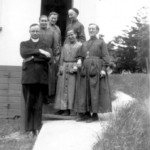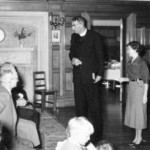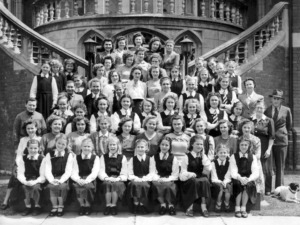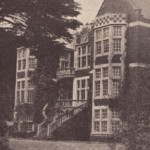Polish Refugees in New Zealand 1944-1951
Exhibitions
Polish Girls Hostel, Lyall Bay
Polish Children’s Reunion Committee 2004: As in the case of the Polish Boys’ Hostel, it was Father John Kavanagh, the Polish children’s legal guardian, who found a suitable property (a beautiful mansion and extensive former home of the Hope-Gibbons family) for setting up the Polish Girls’ Hostel. Part of the cost was covered by the Catholic Bishops’ Curia and the rest by the New Zealand Government.
On 8 December 1947, Queen’s Drive in Lyall Bay, Wellington, became the location for the Polish Girls’ Hostel for the next 10 years – a home for Polish working and school girls. Father Kavanagh stayed for a few days in the empty hostel, then Sister Brennan and two senior girls (Helena Nawrocka and Henryka Nasarzewska) moved in. The home soon began to fill up.
Problems
The Sisters’ plan was that the Polish working and school girls, and later the youngest girls from the camp, would stay in the hostel and be brought up in a Polish, Catholic atmosphere. When they no longer needed the hostel, it would be used as a home for new Polish migrants seeking shelter, children of working mothers and older people needing constant care.
However, the Curia had different plans. Soon after the Sisters moved in, Father Kavanagh informed Sister Alexandrowicz that the Curia wished that only working girls live in the hostel. Moreover, half of them would be Polish and half New Zealand. The younger girls were to be placed with New Zealand families. That information was a blow to the Sisters and the Polish people in Wellington. If this new plan eventuated, the most vulnerable group of the Polish orphans would be placed in the hands of strangers, no matter how loving.
“I was in a boarding school in Dunedin at that time and I remember how frightened I was that ‘they’ would abandon me somewhere among strangers and not let me go back to my friends,” says Stefania Sondej (Manterys).
If this new plan was put into effect, Sister Alexandrowicz foresaw many problems – no Polish, Catholic atmosphere, probably little cooperation of New Zealand girls with Polish nuns, mixed races and different needs, but most of all the youngest Polish orphans would be dispersed among strangers. The Sisters were not against mixed races (they later cared for young children of different races and nationalities) but they wanted to attend first to the special needs of the Polish orphans. “Only tolerance and compassion could heal the scars” in those children, as Father Michael O’Meeghan wrote in Steadfast in Hope.
No amount of persuasion on the part of Sister Alexandrowicz would change Father Kavanagh’s mind. So in desperation and after many prayers, she turned for help to the Polish ex-soldiers, especially Captain Tadeusz Szczerbo-Niefiedowicz, formerly of the Polish navy. He, together with some other Polish ex-soldiers, went to see some Members of Parliament with a petition to look into the matter of the Polish Girls’ Hostel. The petition was successful.
After a consultation of the Government with the Catholic Curia, it was decided that the hostel would remain the property of the Curia but that it would be used solely by the Polish people and the Ursuline Sisters would be in charge.
By the middle of December 1947, the rest of the Sisters and more girls moved in and the hostel was fully operational. It began with 80 girls and at its peak accommodated 120.
First Christmas at the hostel
The first Christmas at the hostel was a moving occasion for the girls and Sisters – familiar and friendly faces, all the Polish traditions associated with Christmas observed and a cheerful, homely atmosphere. Everyone felt that this was their home and that with God’s help they will live there safely and happily.
The Ursuline Sisters at work
Sister Imelda, professionally trained in home science and talented in turning plain ingredients into something delicious, did the cooking and looked after the singing in the chapel.
Sister Augustyna was in charge of all the household cleaning and the convent garden and sometimes exchanged work with Sister Imelda.
Sister Marcina, a quiet, serene person, had a great gift for dealing with very young children – she was very patient and spent many hours playing with them. As a result, they adored her and listened to her every word.
Sister Brennan, somewhat older than the rest of the Sisters, though her deportment was the best in the hostel, was a great organiser. She found a way of simplifying every task that needed doing. For example, to prevent too many dishes being broken, she allotted each girl her plates and cutlery, as well as a pigeon hole, and each girl washed her own dishes under a running tap – quick, hygienic and no arguments. She looked after the library and made sure the equipment, such as the radios and sewing machines, was in working order. She was a very intelligent and cultured person, and would even slip informative books into the room of one of the girls studying for her degree.
Sister Alexandrowicz was an incredible person and the girls were very lucky to have such a person for their “mother” at the hostel. She was strong in character, had unwavering faith in God, really loved people, especially children, and was an excellent administrator. What ordinary matron would sneak round the hostel in the small hours on the eve of St Nicholas’ feast day to hang some lollies on each doorknob? A chapter at least would be needed to describe her. She was responsible for the entire hostel, did the accounts both for the hostel and the girls, ordered and paid for all the supplies and looked after the spiritual welfare of her little band of Ursuline nuns.
She tried to treat each of her young charges as if she were her own child and bring her up accordingly. A formidable task, but her love and dedication produced wonderful results. Because she created such a caring atmosphere, some of the lucky girls, whose fathers came here after demobilisation from the Polish army, were unhappy to leave the hostel.
“The girls living in the hostel were very happy,” says Romualda Waluszewska (Sokalska). “Sister Alexandrowicz was very kind and watched over us like a mother. She often reminded us that the hostel was our ‘home’. During the weekend when the girls went out, she would wait until they all returned safely. At times we felt she cared and worried for us too much. It wasn’t until we became mothers that we realised she was doing it for our own good.”
Over the years, other Polish women helped with various tasks. Maria Sawicka, a nurse, looked after the hygiene of the younger girls and the minor ailments of all. Jadwiga Michalik helped supervise homework, taught national dances and supervised the making of costumes for concerts. Sister Paula, a young Ursuline nun who came here temporarily, produced some Polish plays with the girls. She left in 1954.
House duties and regulations
With so many girls and so few Sisters, it was necessary to introduce some sort of regulations to make life easier for everybody and perhaps employ some lay staff. Sister Alexandrowicz asked the senior girls for any suggestions. They all agreed there was no need to hire additional staff and that they would do the cleaning. Moreover, they agreed that some sorts of rules were necessary for the smooth running of the hostel. A roster for general cleaning on Saturday was written up, prayer times decided (older girls privately, younger ones as a group), times for getting up and making of sandwiches.
On Saturdays there was mending and perhaps sewing of clothes. Older girls sometimes even made dresses for the younger ones. On Mondays after work and school there was the washing of clothes. On Wednesdays, Fridays and Saturdays the older girls could stay out later to 12.30am and on other days the doors were closed at 10pm. If an older girl wished to go out with a boy, he had to be introduced to Sister Alexandrowicz and promise to bring her back himself. During the 11 years of existence of the hostel, the girls rarely broke these rules and never blatantly.
Piety
The girls at the hostel were a pious group. They were taught to have trust in God, to thank Him for their deliverance from the Russian forced-labour camps and to take all their troubles to Him. It was not unusual to see some girl praying in the chapel during odd times of the day. On Sundays the girls dressed in their best clothes and went to Mass, either in the city to Polish Mass once a month or to the hostel’s chapel. Sometimes there were Masses in the chapel during weekdays. All the feast days were observed, as well as the Lenten devotions with all the Lenten Polish hymns, the happy May devotions to Mary, the Rosary devotions in October and meditating on the life of Christ.
Recreation and culture
On Sunday afternoons the girls would play tennis, basketball or netball, go out for a walk or organise a dance to which boys from the Polish Boys’ Hostel, and later Polish ex-soldiers, would come. Father Leahy strongly supported the Polish basketball team Białe Orły (the White Eagles). With his encouragement they even won a tournament in 1951, beating the best team in Wellington.
Sometimes Polish plays would be put on. Often you could hear somebody singing, practising the piano or playing records. The piano was paid for from the profits of a concert held in St Francis’ Hall in which girls from the hostel took part.
Church feast days, national days (such as the Polish Constitution day on 3 May), Christmas, important visits and the 10th anniversary of the Polish children’s arrival in New Zealand gave opportunities to put on a concert for which Polish dances, songs and recitations had to be learned. In 1955, Professor Rytel, a well-known Pole from the US who visited the hostel, was amazed at how well the children spoke Polish. One frustration was the lack of written or recorded music – it had to be recalled from memory and played by ear.
The costumes for dancing, on the other hand, dropped from heaven! Father Leon Broel-Plater, who replaced Father Michał Wilniewczyc as the Polish chaplain, received US$1,000 from the US – a present for the children. From that money, material was bought to make Polish costumes and there was great rejoicing when they were finished. Life was happy and busy.
Girls begin to leave
The girls soon grew into young women. On weekends the hostel swarmed with young men, both Polish and New Zealanders. More and more weddings took place, so that by the time the hostel closed there were many children born to those marriages. Some of those children were brought back to the hostel to be looked after by the Sisters while the mothers worked.
The number of inhabitants in the hostel began to dwindle, not only because of the marriages, but as the girls grew more self assured they sought more independence and looked for private quarters (prywatki) to live in. Some also went to other countries to join relatives. But they all said that nowhere will they have as good a life as they had with the Sisters.
Changes
In about 1952 the Sisters began to accept more and more young children of different nationalities and races – Irish, New Zealand, Italian, Yugoslav, Hungarian, Maori and a Russian girl. Most of them learnt some Polish. One little Italian boy was most entertaining in his patriotism and was very proud of being able to speak Italian. So someone asked: “What’s ‘frog’ in Italian, Alvaro?” Without hesitation, he answered: “Froga!”
The numbers and ages of the children had decreased but not the quality of care nor character of the place. As the children were younger and from such varied cultures, more work was required in looking after their physical and educational needs. The Sisters needed at least one other person to help them. With permission from her Superior in Poland, Sister Alexandrowicz asked her own sister, Jadwiga Alexandrowicz, a qualified teacher who lived in Canada. She arrived in 1955 and left New Zealand with the other Sisters. Intelligent, capable and with a pleasing personality, she was of great help to her sister who by then was showing signs of exhaustion.
Polish children’s 10th anniversary of arrival
Ten years had passed since the Polish children’s arrival in New Zealand on 1 November 1944. The Sisters and girls decided to celebrate that anniversary in their hostel in May 1955. Official guests were invited and notices sent out to former inhabitants of the hostel.
At the jubilee concert was a representative of the Government (Ernest Corbett, MP), a representative of the Catholic Church (Monsignor Arthur McRae), the Rector of Polish Catholic Mission (Father Broel-Plater) and other priests (Father Huzarski who was a Dominican, Father Leahy and Father O’Neill), poet Eileen Duggan and her sister, members of the hostel board, many well wishers, and of course the Sisters and Ngaroma girls, both past and present.
The concert began with very friendly and informal speeches by Minister Corbett, Monsignor McRae, Father Broel-Plater and Stefania Sondej (Manterys) on behalf of the girls. There were Polish dances and recitations but the most exciting and moving part was the documentary of the arrival of the Polish children in New Zealand, filmed by the National Film Unit. The excited, confident and healthy young adults watched the pathetic-looking children in the film, recognised themselves, and here and there tears began to flow. But the film reminded them also of the extraordinary friendliness with which the people of New Zealand welcomed them those 10 years before. The hostel also resounded with excited voices of young mothers showing off their “home” to their families.
More changes
Eventually, there were fewer than 40 ex-Pahiatua girls remaining at the hostel, and more and more young children of different nationalities came to stay for various reasons, plus children of former hostel girls and girls coming for long holidays from boarding schools. Young children required more individual attention and care, so Sister Alexandrowicz applied to her Superior in Poland for more Sisters. After months of waiting, on 8 August 1957, she received a reply – their Superior in Poland decided to recall the Ursuline Sisters to Poland.
There followed a sad and difficult period of finding new homes for the hostel children and preparing for departure – a painful wrench for the Sisters. Going home did not fill them with joy. Poland was in communist hands where convents were being closed, nuns persecuted and their schools secularised. But most of all, the Sisters in New Zealand had become part of the Pahiatua children’s lives and vice versa. They were a valuable asset not only to the Polish people but to New Zealand, but would play only a minor part in Poland. The last of the older girls to leave the hostel were Ola Szulgan, who left in a wedding dress to marry Mieczysław Lis. Stefania Sondej (Manterys), who left at the same time, was her bridesmaid.
Farewell – 9 March 1958
Sunday. The day began with a Mass celebrated at St Anne’s church by Father Broel-Plater. After Mass the Polish community in Wellington gathered in St Anne’s Hall, Newtown. It was full but the people were subdued. The following people gave speeches, all thanking the Sisters and regretting their departure – Father O’Neil (representing Archbishop McKeefry), the Polish chaplain Father Broel-Plater, Ellinor Zaleska (wife of the last delegate of the Polish Government-in-Exile), Kazimierz Wodzicki (the last Consul of independent Poland), Bronisław Nawrocki (president of the Polish Association), Jerzy Pobóg-Jaworowski (president of the Polish Ex-Combatants Association) and Stefania Sondej (Manterys) on behalf of the hostel girls.
Ursuline Sisters’ departure
Sisters Alexandrowicz, Imelda, Augustyna, Marcina and Brennan left New Zealand on 13 March 1958 on the ship Monowai. Ngaroma changed hands several times. In 1986 the Polish Pope John Paul II stayed there during his visit to New Zealand. In 2004 it was the residence of the Apostolic Nuncio.
New Zealand’s First Refugees: Pahiatua’s Polish Children (3rd edition); p338-345
Voices
Photos










